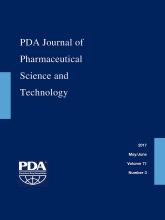Abstract
This article reports the validation strategy used to demonstrate that the Milliflex® Quantum yielded non-inferior results to the traditional bioburden method. It was validated according to USP <1223>, European Pharmacopoeia 5.1.6, and Parenteral Drug Association Technical Report No. 33 and comprised the validation parameters robustness, ruggedness, repeatability, specificity, limit of detection and quantification, accuracy, precision, linearity, range, and equivalence in routine operation. For the validation, a combination of pharmacopeial ATCC strains as well as a broad selection of in-house isolates were used. In-house isolates were used in stressed state. Results were statistically evaluated regarding the pharmacopeial acceptance criterion of ≥70% recovery compared to the traditional method. Post-hoc test power calculations verified the appropriateness of the used sample size to detect such a difference. Furthermore, equivalence tests verified non-inferiority of the rapid method as compared to the traditional method. In conclusion, the rapid bioburden on basis of the Milliflex® Quantum was successfully validated as alternative method to the traditional bioburden test.
LAY ABSTRACT: Pharmaceutical drug products must fulfill specified quality criteria regarding their microbial content in order to ensure patient safety. Drugs that are delivered into the body via injection, infusion, or implantation must be sterile (i.e., devoid of living microorganisms). Bioburden testing measures the levels of microbes present in the bulk solution of a drug before sterilization, and thus it provides important information for manufacturing a safe product. In general, bioburden testing has to be performed using the methods described in the pharmacopoeias (membrane filtration or plate count). These methods are well established and validated regarding their effectiveness; however, the incubation time required to visually identify microbial colonies is long. Thus, alternative methods that detect microbial contamination faster will improve control over the manufacturing process and speed up product release. Before alternative methods may be used, they must undergo a side-by-side comparison with pharmacopeial methods. In this comparison, referred to as validation, it must be shown in a statistically verified manner that the effectiveness of the alternative method is at least equivalent to that of the pharmacopeial methods. Here we describe the successful validation of an alternative bioburden testing method based on fluorescent staining of growing microorganisms applying the Milliflex® Quantum system by MilliporeSigma.
- © PDA, Inc. 2017
PDA members receive access to all articles published in the current year and previous volume year. Institutional subscribers received access to all content. Log in below to receive access to this article if you are either of these.
If you are neither or you are a PDA member trying to access an article outside of your membership license, then you must purchase access to this article (below). If you do not have a username or password for JPST, you will be required to create an account prior to purchasing.
Full issue PDFs are for PDA members only.
Note to pda.org users
The PDA and PDA bookstore websites (www.pda.org and www.pda.org/bookstore) are separate websites from the PDA JPST website. When you first join PDA, your initial UserID and Password are sent to HighWirePress to create your PDA JPST account. Subsequent UserrID and Password changes required at the PDA websites will not pass on to PDA JPST and vice versa. If you forget your PDA JPST UserID and/or Password, you can request help to retrieve UserID and reset Password below.






